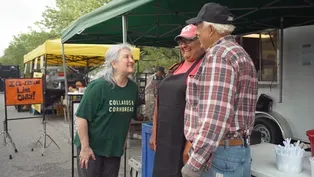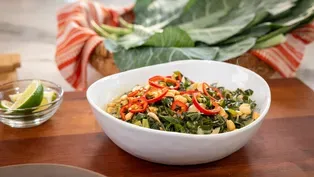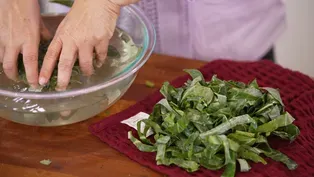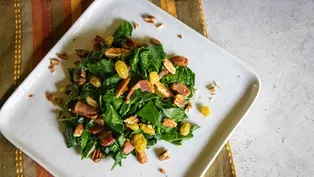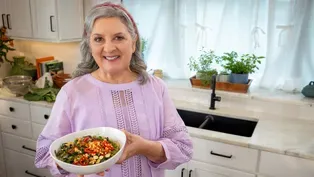
Field Trip to the Utopian Seed Project
Clip: 10/7/2024 | 4m 51sVideo has Closed Captions
Sheri visits a collard farm and talks about the harvest with collard expert Chris Smith.
Sheri visits a collard farm outside Asheville, where she discusses the harvest with collard expert Chris Smith. As executive director of the Utopian Seed project, he shows Sheri how cultivating variety helps build resiliency for the leafy greens.

Field Trip to the Utopian Seed Project
Clip: 10/7/2024 | 4m 51sVideo has Closed Captions
Sheri visits a collard farm outside Asheville, where she discusses the harvest with collard expert Chris Smith. As executive director of the Utopian Seed project, he shows Sheri how cultivating variety helps build resiliency for the leafy greens.
How to Watch The Key Ingredient
The Key Ingredient is available to stream on pbs.org and the free PBS App, available on iPhone, Apple TV, Android TV, Android smartphones, Amazon Fire TV, Amazon Fire Tablet, Roku, Samsung Smart TV, and Vizio.
Providing Support for PBS.org
Learn Moreabout PBS online sponsorship[bright guitar music] Chris Smith and his fellow farmers at The Utopian Seed Project are serious about collards.
They preserve historic varieties and develop new ones that can see us into future generations.
There's no better guide to walk me through a wintertime collar patch.
Hello, my friend.
- Hey Sheri.
- [Sheri] How are you?
- Very good, very good.
- [Sheri] It's good to see you.
Thanks for having me out today.
- I appreciate you coming out to the mountains.
- Yes, and I see that you arranged our mountain weather for us, a little rain here for a few minutes and so forth.
So I'm here to learn about collards.
- We have some collards to show you.
- Okay.
- Yep.
I run a project called The Utopian Seed Project.
We're at one of my board members houses, which is Yanna Fishman, and she's got this beautiful farm.
So I wanted to bring you here just to show you some of the collards that she was growing.
- [Sheri] How many collards are there in the world?
- Whoa, in the world, I don't know if I have that number, but in our world, then we have access to about 100 varieties of different collards.
- No kidding.
- Yeah, yeah.
- And are collards native to North America or where did they come from?
- Collards started off in Northern Europe.
They weren't really that well appreciated, but with the transatlantic slave trade, we had lots of African people being forcibly brought to the Southern United States, and they had a real appreciation of these dark leafy greens, but didn't have access to the foods of their cultures from Africa.
And we see collards being developed and appreciated as a true African American crop, which is pretty special in terms of American foodways.
- [Sheri] It seems to me that collards are one of the few greens that're available all year round, is that true?
- It depends on where you're growing.
Eastern North Carolina, you've got a full 12-month season on collards.
They're pretty cold-tolerant, so we've had multiple frosts here, and you can see the collards are alive and beautiful.
- Is there a size that these reach?
When you pick them, are the hearts tender?
How do you know when a collard is ready to pick?
- One of the beautiful things about growing greens is that it's edible from the tiniest sprout, depending on what you're doing with them.
When they're real small, they tend to be a little more tender.
As they get bigger, they tend to be a little bit tougher.
[bright music] - All right, I want you to show me how to pick a leaf here.
Do you cut 'em?
Do you pinch 'em?
- You can break them off at the stem.
They'll just snap off.
So these collards are so tender, you can eat them raw.
You can eat them raw at all stages, but the younger leaves are a little more tender, so I'll give you one of them.
That's a little baby one from the center.
Look at that.
Here we go, cheers.
- Cheers.
- Oh wow.
It's more tender than cabbage.
It's really sweet.
That is amazing.
Oh my goodness.
I'm a convert.
This is delicious.
- It's a whole new world of raw collards.
- A whole new world.
Why is it important to keep your diversity?
- So the environment and the climate is rapidly changing.
It's becoming way harder to grow food because of crazy weather events, spiked temperatures, early freezes.
And if we just have one variety that works in one set of conditions, then when those conditions change, that one variety can't cope.
But if we've got a huge amount of variety to choose from, then we can build more resilience into the food system, 'cause these might work in one set of conditions, but that variety over there might work in a different set.
And so when we have a whole food system with a myriad of different varieties and crop types, then we have a much stronger food system.
- That gives me some hope that some of those really old things might be what saves us in the long run, so I'm gonna keep eating collards.
- Yeah, they're delicious.
There's more to show you.
So, I've brought some collards from my other farm that I'd love to just show you all the different beautiful things.
- I'm here for it.
- Yeah, let's do it.
[bright music] So what I brought you here is an example of all those different varieties that I referenced before.
- Right, that looks like a flower arrangement.
It's gorgeous.
- Yeah, it's really pretty.
And there's just different leaf shapes and types.
So maybe I can just show you a few of the ones that excite me, or you can pick one out, and we can talk about it.
I mean, these purple ones are something that we've been looking at.
- It looks like red Russian kale, that's what I would think that was, but yet it's a collard.
- Yeah, usually with a collard, it's these smooth savoy-type shape, but this is deeply frilled, but it's still a collard.
- Look at this.
I'm gonna use this as a corsage.
- You really could.
So there's the deep purple ones that we've been looking at, but then look at this.
I'm gonna pull out the whole bunch.
There you go.
I feel like I should present it to you.
- No kidding, I know.
I feel like I've just won something.
- The textures in that leaf are just like- - It's beautiful.
- cosmic, actually.
We just love showing off to people that collards are more than just a basic green leaf.
There's all this beauty that you can explore, and people should get excited about that, so many things to explore.
- So many things to explore.
I'm in love with this one.
I'm going to wear it today.
- You can keep that one.
That one's yours.
- Thank you, thank you so much.
- And I'll give you some seeds.
- Thank you, thank you for your knowledge and for doing this.
I thought I knew collards.
I didn't know diddly squat.
Thank you.
[upbeat music]
Collard & Cornbread Sandwiches | Cook Along with Glenn & Dorsey Hunt
Video has Closed Captions
Sheri cooks along with Glenn and Dorsey Hunt to make collard-and-cornbread sandwiches. (4m 31s)
Green Curry and Coconut Creamed Collards | Kitchen Recipe
Video has Closed Captions
Sheri’s recipe for green curry and coconut creamed collards will make you rethink leafy greens. (6m 27s)
How to Clean and Prep Collard Greens
Video has Closed Captions
Sheri shares a game-changing hack for quickly conquering a stack of collard greens. (1m 49s)
Kitchen Recipe – Collard Salad
Video has Closed Captions
Sheri Castle brings flair from her mountain upbringing to her collard salad with hot bacon dressing. (7m 2s)
Preview | Turning Over a New Collard Leaf
Video has Closed Captions
Host Sheri Castle offers a fresh look at a Southern favorite, collard greens. (30s)
Providing Support for PBS.org
Learn Moreabout PBS online sponsorship